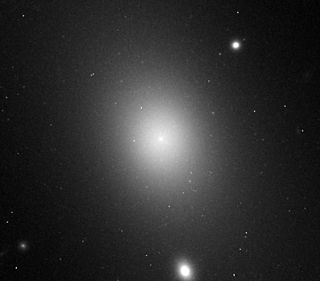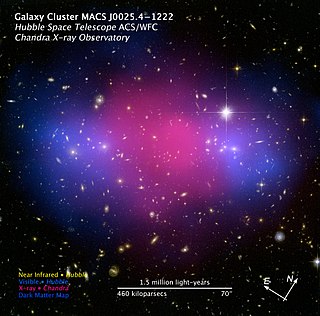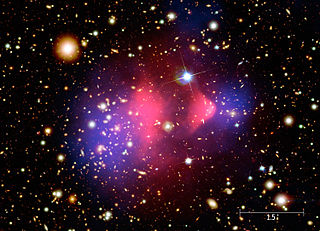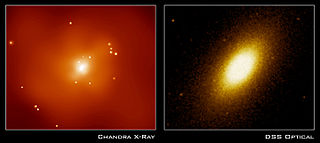In astronomy, dark matter is a hypothetical form of matter that appears not to interact with light or the electromagnetic field. Dark matter is implied by gravitational effects which cannot be explained by general relativity unless more matter is present than can be seen. Such effects occur in the context of formation and evolution of galaxies, gravitational lensing, the observable universe's current structure, mass position in galactic collisions, the motion of galaxies within galaxy clusters, and cosmic microwave background anisotropies.
The study of galaxy formation and evolution is concerned with the processes that formed a heterogeneous universe from a homogeneous beginning, the formation of the first galaxies, the way galaxies change over time, and the processes that have generated the variety of structures observed in nearby galaxies. Galaxy formation is hypothesized to occur from structure formation theories, as a result of tiny quantum fluctuations in the aftermath of the Big Bang. The simplest model in general agreement with observed phenomena is the Lambda-CDM model—that is, that clustering and merging allows galaxies to accumulate mass, determining both their shape and structure. Hydrodynamics simulation, which simulates both baryons and dark matter, is widely used to study galaxy formation and evolution.

A galaxy cluster, or a cluster of galaxies, is a structure that consists of anywhere from hundreds to thousands of galaxies that are bound together by gravity, with typical masses ranging from 1014 to 1015 solar masses. They are the second-largest known gravitationally bound structures in the universe after some superclusters (of which only one, the Shapley Supercluster, is known to be bound). They were believed to be the largest known structures in the universe until the 1980s, when superclusters were discovered. One of the key features of clusters is the intracluster medium (ICM). The ICM consists of heated gas between the galaxies and has a peak temperature between 2–15 keV that is dependent on the total mass of the cluster. Galaxy clusters should not be confused with galactic clusters (also known as open clusters), which are star clusters within galaxies, or with globular clusters, which typically orbit galaxies. Small aggregates of galaxies are referred to as galaxy groups rather than clusters of galaxies. The galaxy groups and clusters can themselves cluster together to form superclusters.

A ring galaxy is a galaxy with a circle-like appearance. Hoag's Object, discovered by Arthur Hoag in 1950, is an example of a ring galaxy. The ring contains many massive, relatively young blue stars, which are extremely bright. The central region contains relatively little luminous matter. Some astronomers believe that ring galaxies are formed when a smaller galaxy passes through the center of a larger galaxy. Because most of a galaxy consists of empty space, this "collision" rarely results in any actual collisions between stars. However, the gravitational disruptions caused by such an event could cause a wave of star formation to move through the larger galaxy. Other astronomers think that rings are formed around some galaxies when external accretion takes place. Star formation would then take place in the accreted material because of the shocks and compressions of the accreted material.
A galactic halo is an extended, roughly spherical component of a galaxy which extends beyond the main, visible component. Several distinct components of a galaxy comprise its halo:

In modern models of physical cosmology, a dark matter halo is a basic unit of cosmological structure. It is a hypothetical region that has decoupled from cosmic expansion and contains gravitationally bound matter. A single dark matter halo may contain multiple virialized clumps of dark matter bound together by gravity, known as subhalos. Modern cosmological models, such as ΛCDM, propose that dark matter halos and subhalos may contain galaxies. The dark matter halo of a galaxy envelops the galactic disc and extends well beyond the edge of the visible galaxy. Thought to consist of dark matter, halos have not been observed directly. Their existence is inferred through observations of their effects on the motions of stars and gas in galaxies and gravitational lensing. Dark matter halos play a key role in current models of galaxy formation and evolution. Theories that attempt to explain the nature of dark matter halos with varying degrees of success include cold dark matter (CDM), warm dark matter, and massive compact halo objects (MACHOs).

Abell 400 is a galaxy cluster which contains the galaxy NGC 1128 with two supermassive black holes spiraling towards merger.

IC 1101 is a class S0 supergiant (cD) lenticular galaxy at the center of the Abell 2029 galaxy cluster. It has an isophotal diameter at about 123.65 to 169.61 kiloparsecs. It possesses a diffuse core which is the largest known core of any galaxy to date, and contains a supermassive black hole, one of the largest discovered. The galaxy is located at 354.0 megaparsecs from Earth. The galaxy was discovered on 19 June 1790, by the British astronomer William Herschel.

Abell 1689 is a galaxy cluster in the constellation Virgo over 2.3 billion light-years away.
The Deep Lens Survey is an ultra-deep multi-band optical survey of seven 4 square degree fields. Mosaic CCD imagers at the National Optical Astronomy Observatory's Blanco and Mayall telescopes are being used. The deep fields took five years to complete (2001–2006), in four bands: B, V, R, and z', to 29/29/29/28 mag per square arcsecond surface brightness. Optical transient events and supernova candidates are released in real time.

The Bullet Cluster consists of two colliding clusters of galaxies. Strictly speaking, the name Bullet Cluster refers to the smaller subcluster, moving away from the larger one. It is at a comoving radial distance of 1.141 Gpc.

Abell 520 is a galaxy cluster in the Orion constellation, located at a co-moving radial distance of 811 Mpc (2,645 Mly) and subtends 25 arcminutes on the Earth sky.

MACS J0025.4-1222 is a galaxy cluster created by the collision of two galaxy clusters, and is part of the MAssive Cluster Survey (MACS). Like the earlier discovered Bullet Cluster, this cluster shows a clear separation between the centroid of the intergalactic gas and the colliding clusters.

Abell 2142, or A2142, is a huge, X-ray luminous galaxy cluster in the constellation Corona Borealis. It is the result of a still ongoing merger between two galaxy clusters. The combined cluster is six million light years across, contains hundreds of galaxies and enough gas to make a thousand more. It is "one of the most massive objects in the universe."

Abell 2744, nicknamed Pandora's Cluster, is a giant galaxy cluster resulting from the simultaneous pile-up of at least four separate, smaller galaxy clusters that took place over a span of 350 million years, and is located approximately 4 billion light years from Earth. The galaxies in the cluster make up less than five percent of its mass. The gas is so hot that it shines only in X-rays. Dark matter makes up around 75 percent of the cluster's mass.
Abell 222 is a galaxy cluster in the constellation of Cetus. It holds thousands of galaxies together. It is located at a distance of 2.4 billion light-years from Earth.
The Bullet Group is a newly merging group of galaxies, a merger between two galaxy groups to form a new larger one, that recently had a high speed collision between the two component groups. The group exhibits separation between its dark matter and baryonic matter components. The galaxies occur in two clumps, while the gas has expanded into a billowing cloud encompassing all three clumps. As of 2014, it is one of the few galaxy clusters known to show separation between the dark matter and baryonic matter components. The group is named after the Bullet Cluster, a similar merging galaxy cluster, except on a smaller scale, being of groups instead of clusters. The bimodal distribution of galaxies was found at discovery in 2008. The galaxy group is a gravitational lens and strongly lenses a more distant galaxy behind it, at z=~1.2

The Bullet Galaxy (RXC J2359.3-6042 CC) is a galaxy in the galaxy cluster RXC J2359.3-6042 (Abell 4067 or ACO 4067). The Bullet Galaxy is the sole component of one half of a cluster merger between the bulk of the cluster and this galaxy, which is plowing through the cluster, similar to how merging clusters Bullet Cluster and Bullet Group have merged. Unlike those two mergers, the Bullet Galaxy's merger is between one galaxy and a galaxy cluster. The cluster merger is happening at a lower speed than the Bullet Cluster, thus allowing the core of the Bullet Galaxy to retain cool gas and remain relatively undisturbed by its passage through the larger cluster. This cluster merger is the first one observed between a single galaxy and a cluster. The galaxy and cluster lies at redshift z=0.0992, some 1.4×109 ly (4.3×108 pc) away. The galaxy is traveling through the cluster at a speed of 1,310 km/s (2,900,000 mph).

NGC 720 is an elliptical galaxy located in the constellation Cetus. It is located at a distance of circa 80 million light years from Earth, which, given its apparent dimensions, means that NGC 720 is about 110,000 light years across. It was discovered by William Herschel on October 3, 1785. The galaxy is included in the Herschel 400 Catalogue. It lies about three and a half degrees south and slightly east from zeta Ceti.













